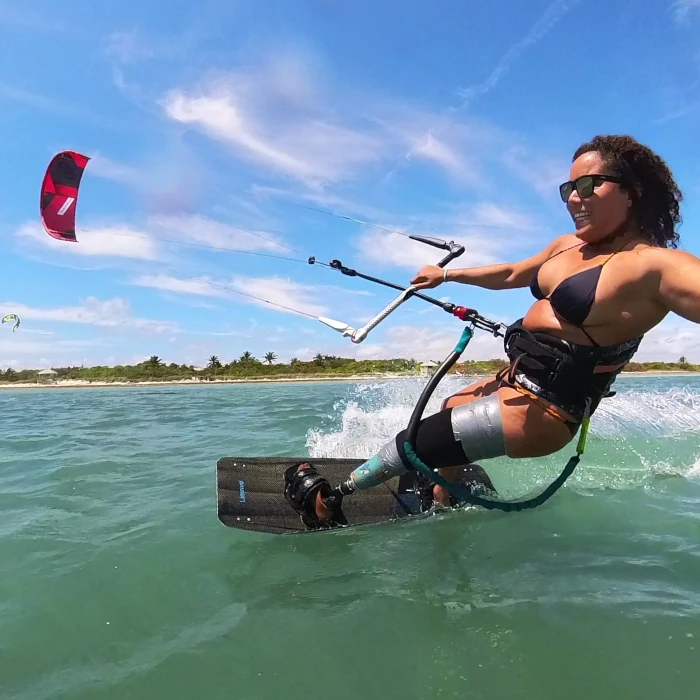Frances Rivera never skied on two legs. Growing up in Puerto Rico, she didn’t have a lot of opportunity to take up snowsports, nor much interest. And when she lost her leg in 2011, the sport she turned to for fun and fitness was her lifelong passion: kiteboarding.
“Kiteboarding is very similar to wakeboarding, but instead of getting pulled by a boat, you’re harnessing the wind,” Rivera explains. “You have a kite and four lines that connect to it, and that’s connected to a harness. I started in 2007, before I joined the military. I tried it out for a few hours and fell in love with it, and it has been part of my life ever since.”
Unexpectedly, snowboarding’s now part of Rivera’s life, too. It has been ever since 2019, when she attended the annual Disabled Veterans Winter Sports Clinic for the first time. She’ll be back next month for the week-long event, now in its 38th year. Cosponsored by the VA and Disabled American Veterans, the clinic draws several hundred wounded warriors from all over the country to Colorado’s Snowmass resort, near Aspen. Activities range from downhill skiing to sled hockey, rock climbing, nordic skiing, and snowboarding.
It’s no surprise that snowboarding is Rivera’s mountain pastime of choice. Do her kiteboarding skills translate well to that sport?
“They do and they don’t,” she says. “They do because I do have a proper understanding of core balance and proper standing for the most part. But it’s not the same in regards to how much pressure you put on your feet. With snowboarding, you’re throwing yourself to the front of the mountain. Kiteboarding is the complete opposite. You’re leaning back and putting all your pressure on your back leg. When I tried to translate that to snowboarding, at first I was falling a lot on my butt.”
Rivera is more adept at staying upright after several trips to the Winter Sports Clinic, but becoming an expert shredder isn’t the point. She’s there for the camaraderie and the chance to promote healing among disabled veterans. This year’s event runs from April 1 through April 7; here’s how you can get involved.
Supporting disabled vets is an ongoing commitment for Rivera. She spends much of the year teaching disabled veterans how to kiteboard, offering lessons through two nonprofits: the Veterans Adventure Group and Wind Sports for Warriors.
“When I lost my leg, I was really struggling,” she says. “After a lot of soul-searching and a lot of thought, I felt the best way I could continue to serve not only my country, but also my fellow servicemembers, was by giving them a way to cope with trauma, injury, and mental illness, and to promote the sense of community that the military provides.”
Of course, before she could teach, Rivera had to re-learn to kiteboard herself after limb loss. Unfortunately, there weren’t any instructors around who had worked with amputee riders before.
“We were pretty much making it up as we went,” she laughs. “We were just trying different things to see what would work, and a lot of things didn’t work too good. So it was an interesting process, to be a guinea pig.”
No such barriers confront amputee riders when they attend one of Rivera’s clinics today. As a certified kiteboard instructor with credentials from the Professional Air Sports Association, she has teaching down to a tee. Most adaptive riders only need a few hours of practice to get the hang of it. And once they get going, Rivera says, it’s a joy to watch.
“It gives them a sense of fulfillment in every aspect and every emotion,” she says. “It brings a full sense of fulfillment, of action, of adrenaline, that they haven’t felt for a long time. One of the advantages of kiteboarding over wakeboarding is that you can ride for longer periods of time. You’re wearing a harness, and that transfers some of the power from your hands and shoulders to your abdomen and your legs. With wakeboarding, your forearms are just destroyed after four or five minutes. A good kiteboarding session can last an hour or an hour and a half.”
Adaptive kiteboarding has come a long way since Rivera learned to do it more than a decade ago. If you’re interested in learning, you can probably find a certified instructor within a reasonable distance. If there’s not a decent body of water nearby, you might consider trying landboarding—same concept is kiteboarding, but you zip across terra firma on a modified skateboard.
So if you can kite across dry land . . . . what’s to stop a person from strapping on a kite at Snowmass next week and sailing across the mountain during the Winter Sports Clinic?
“Oh sure, you can go snowkiting,” Rivera says. “But not at Snowmass. I actually asked to offer this for a Winter Sports Clinic event one time, and I was very quickly stopped by the snow patrol. They said, ‘Absolutely not.’ You usually wouldn’t do it at a ski resort anyway. You need to do it where there is a lot of open space, not a lot of obstructions.”
So you’ll find Rivera on her snowboard next week. If you see her, remind her to keep her weight shifted forward, not back. You can follow her on Instagram at la_fran_kite. Get more info about the Winter Sports Clinic at wintersportsclinic.org.
